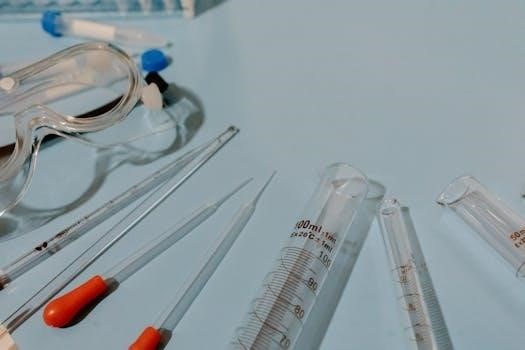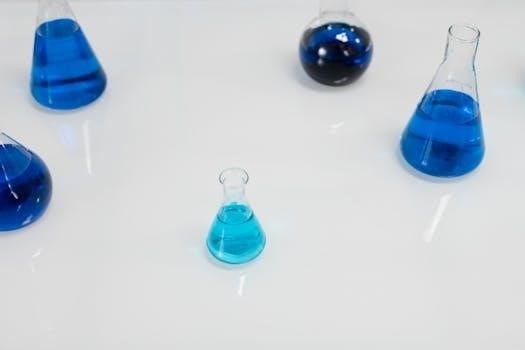This guide explores fundamental chemistry experiments, providing a hands-on approach to learning. It focuses on practical activities, moving beyond theoretical knowledge. Real lab work is emphasized, teaching key concepts through direct experimentation. The resource is ideal for students and DIY enthusiasts.
Overview of Basic Chemistry Experiments
Basic chemistry experiments are crucial for understanding fundamental scientific principles. These experiments often involve simple procedures and readily available materials, making them accessible for home or educational settings. They cover core concepts, such as chemical reactions, measurement, and properties of matter. Experiments might include observing the combustion of magnesium, reacting zinc with acid, or heating lead nitrate to identify reaction types. Another example is the synthesis of aspirin, demonstrating organic chemistry principles by reacting salicylic acid with acetic anhydride. Further, experiments such as determining the pH of various substances using indicators and conducting titrations to measure acid/base concentrations are also important. These hands-on activities help develop essential laboratory skills, such as precise measurement and careful observation. They also foster a deeper understanding of chemical processes through direct experience and practical application. The focus is on making abstract concepts tangible and engaging learners in the scientific method. The experiments are designed to be educational and safe when proper precautions are followed.

Setting up a Home Chemistry Lab
Creating a home chemistry lab requires careful planning and consideration for safety. Essential equipment, like glassware, and safety gear should be acquired. Proper organization and a designated workspace are also necessary.
Essential Equipment for Home Experiments
Setting up a functional home chemistry lab requires a collection of basic and specialized equipment. Essential glassware includes beakers, flasks, test tubes, and graduated cylinders for measuring and mixing liquids. A balance, ideally digital, is crucial for accurate mass measurements. Safety goggles and gloves are paramount for personal protection. A heat source, such as a hot plate, is needed for controlled heating. Other necessary items are stirring rods, funnels, and filter paper. A pH meter or indicator solutions are vital for acid-base studies. For experiments involving gases, gas collection tubes and stoppers are beneficial. Having a variety of chemicals, such as acids, bases, and salts, is also necessary. Finally, a well-ventilated area is essential for safety when working with chemicals. This collection of equipment will allow for the performance of many exciting and educational chemistry experiments.
Safety Precautions in Home Labs
Prioritizing safety is crucial when conducting chemistry experiments at home. Always wear safety goggles to protect your eyes from chemical splashes. Use gloves to prevent skin contact with hazardous substances. Conduct experiments in a well-ventilated area to avoid inhaling toxic fumes. Never eat, drink, or smoke while working in the lab. Keep a fire extinguisher nearby in case of emergencies. Dispose of chemical waste properly according to local guidelines. Read and understand all instructions before beginning any experiment. Avoid mixing chemicals without knowing the potential reactions. Store chemicals in labeled, secure containers away from children and pets. In case of an accident, be prepared with a first-aid kit. If an experiment involves heat, use appropriate safety equipment. Be aware of the chemicals you are using and their dangers. Always work with a responsible adult when needed, especially for complex experiments.

Core Chemistry Experiment Categories
This section categorizes experiments into acids and bases, gases, and organic compounds. These core areas provide a broad understanding of chemistry. Each category includes specific experiments designed for practical learning.
Experiments with Acids and Bases
Exploring acids and bases is fundamental in chemistry, involving experiments that demonstrate their properties and reactions. These experiments often use indicators to show pH changes, such as observing color shifts when adding an acid or base to a solution. A classic experiment is titrating a strong acid with a strong base to determine the endpoint using a pH meter, allowing for precise measurements of concentrations. Another experiment explores the pH of common household items, like fruit juices, to understand their acidic or basic nature and using pH paper or indicators to determine the acidity or alkalinity of substances; Furthermore, the variation of pH with dilutions can be observed. This helps in understanding the concept of pH and how it is affected by changes in concentration. The study of equilibrium shifts in reactions involving acids and bases is also important, showing how these reactions are influenced by different factors.
Experiments with Gases
Experiments involving gases provide a practical understanding of their properties and behavior. These experiments often include the generation and collection of gases using chemical reactions. One common procedure is producing oxygen through the decomposition of hydrogen peroxide, or generating carbon dioxide from the reaction of an acid with a carbonate. These gases can then be collected and their properties examined, like observing how carbon dioxide extinguishes a flame. Also, investigating the volume relationships of gases through experiments that demonstrate Boyle’s Law or Charles’s Law is also very important, allowing students to explore the relationship between pressure, volume, and temperature. Additionally, conducting tests to identify various gases based on their characteristic reactions is also a good activity, like using limewater to confirm the presence of carbon dioxide. The experiments teach important principles of chemistry and provide valuable hands-on experience.
Experiments with Organic Compounds
Exploring organic compounds through experiments reveals their unique structures and reactions. A key experiment is the synthesis of aspirin, which demonstrates esterification using salicylic acid and acetic anhydride. This process not only produces a common drug but also illustrates the fundamental principles of organic synthesis. Another practical activity involves making soap from fats or oils, highlighting saponification, a basic reaction involving esters. Moreover, investigating the properties of alcohols and acids through simple reactions, such as oxidation or ester formation, is also a very good choice. The identification of different organic functional groups through characteristic chemical tests, like testing for aldehydes or ketones, is also essential. These hands-on activities provide crucial practical insight into the concepts of organic chemistry, and they also help in the understanding of the chemical properties of many substances that are used daily.

Specific Experiments and Techniques
This section covers detailed procedures for key experiments. It includes the synthesis of aspirin, a common organic reaction. Titration experiments, which are very important, are also described. Measurement and density activities teach essential lab skills using a variety of methods.
Synthesis of Aspirin Experiment
The synthesis of aspirin is a fundamental experiment in organic chemistry, demonstrating a common drug preparation method. This process involves reacting salicylic acid with acetic anhydride, using a trace amount of acid as a catalyst. Aspirin, known as an analgesic and antipyretic, is produced through this esterification reaction. The experiment provides a hands-on understanding of organic synthesis, illustrating how simple reactants can form a complex compound with medicinal properties. Detailed instructions are available, guiding you through each step of the procedure. The experiment allows students to learn about reaction mechanisms, purification techniques, and yield calculations. Performing this synthesis provides valuable experience in handling organic chemicals and using laboratory equipment. Careful measurement of reactants and controlled heating are crucial for success. Through this process, students grasp the practical applications of chemical reactions in pharmaceutical development. This experiment also emphasizes the importance of safety in organic chemistry labs.
Titration Experiments
Titration experiments are a cornerstone of quantitative chemical analysis, crucial for determining the concentration of a solution. These experiments typically involve the controlled addition of a solution with a known concentration to another solution until the reaction reaches completion. The point of completion, known as the equivalence point, can be observed using an indicator or pH meter. Common titrations involve acid-base reactions, but other types like redox titrations are also important. The technique requires careful measurements of volumes and concentrations. Titration experiments provide practical experience with volumetric glassware and data analysis. Understanding titration principles is essential for analytical chemistry. Students learn to perform titrations accurately, record data, and calculate unknown concentrations. The experiments often use standard solutions, which have precisely known concentrations. These standard solutions are prepared carefully. Titration experiments solidify understanding of stoichiometry and solution chemistry concepts. The application extends to many fields, including environmental monitoring and pharmaceutical quality control. Safety precautions are necessary when dealing with chemical solutions.
Measurement and Density Experiments
Experiments involving measurement and density are fundamental in chemistry, highlighting the quantitative nature of the science. These experiments provide hands-on experience with laboratory tools and techniques to gather accurate data. Measurement is crucial in all scientific endeavors. Density, a physical property, is defined as mass per unit volume. Experiments typically involve determining the mass and volume of substances, often using balances and graduated cylinders. Calculations are then performed to determine density. Students learn to handle equipment carefully to minimize errors. The experiments reinforce understanding of units, significant figures, and accuracy. They also introduce the concept of precision in measurements. Data analysis helps students to understand experimental results. These experiments provide a practical understanding of density’s role in material identification. This type of experiment also demonstrates how density relates to physical properties. Furthermore, it allows students to explore the relationship between mass, volume, and density. Through these activities, students develop critical skills in data collection and interpretation.

Additional Resources and Information
This section offers supplementary materials for further exploration. It includes links to online resources for experiments and chemistry lab manuals. These materials provide additional guidance and support for advanced learning.
Online Resources for Chemistry Experiments
Numerous online platforms offer valuable resources for chemistry experiments. These platforms provide interactive simulations, step-by-step guides, and detailed explanations of chemical processes. Websites often feature experiment worksheets and results, aiding both students and educators. Additionally, online forums and communities allow for discussion and information exchange among enthusiasts. Many sites offer downloadable PDFs, allowing users to access materials offline. Resources range from basic to advanced experiments, catering to various skill levels. Some websites provide interactive tools for data analysis and visualization. Furthermore, video tutorials offer visual demonstrations of complex procedures. These digital tools enhance the learning experience, making chemistry more accessible and engaging. Online resources can also help with understanding the theoretical basis behind each experiment, combining practical activity with deep learning. These resources are continually updated with new experiments, ensuring a rich and evolving learning experience. Utilizing online resources effectively can significantly improve comprehension and practical skills in chemistry.
Chemistry Lab Manuals and PDFs
Chemistry lab manuals and PDFs serve as essential guides for conducting experiments. These resources provide detailed instructions, safety protocols, and theoretical backgrounds for a wide range of experiments. Lab manuals often include pre-lab questions, step-by-step procedures, and post-lab analysis tasks. PDFs offer a convenient format for accessing these materials on various devices. Many manuals are designed for specific educational levels, from introductory to advanced chemistry courses. They often contain equipment lists, chemical information, and data tables for recording results. Lab manuals and PDFs are crucial for ensuring experiments are conducted safely and accurately. Some manuals include visual aids, such as diagrams and illustrations, to clarify procedures. These resources also help students understand the underlying principles of chemistry through practical application. Availability online makes access easier for learning and preparation. Lab manuals and PDFs are essential for anyone engaging in chemistry experiments, providing guidance and reference throughout the process. They allow for structured learning, helping ensure accurate data collection. These resources are a cornerstone of chemistry education.
